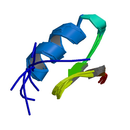| Record Information |
|---|
| Version | 2.0 |
|---|
| Creation Date | 2009-07-03 22:19:11 UTC |
|---|
| Update Date | 2014-12-24 20:25:39 UTC |
|---|
| Accession Number | T3D2525 |
|---|
| Identification |
|---|
| Common Name | Tamapin |
|---|
| Class | Protein |
|---|
| Description | Tamapin is a peptide toxin produced by the Eastern Indian scorpion (Mesobuthus tamulus). It blocks small conductance calcium-dependent potassium channels. (2) |
|---|
| Compound Type | - Amide
- Amine
- Animal Toxin
- Natural Compound
- Organic Compound
- Protein
- Scorpion Toxin
|
|---|
| Protein Structure |  |
|---|
| Synonyms | | Synonym | | Potassium channel toxin alpha-KTx 5.4 |
|
|---|
| Chemical Formula | Not Available |
|---|
| Average Molecular Mass | 3465.100 g/mol |
|---|
| CAS Registry Number | 508220-81-3 |
|---|
| Sequence | Not Available |
|---|
| Chemical Taxonomy |
|---|
| Description | Not Available |
|---|
| Kingdom | Organic Compounds |
|---|
| Super Class | Organic Acids |
|---|
| Class | Carboxylic Acids and Derivatives |
|---|
| Sub Class | Amino Acids, Peptides, and Analogues |
|---|
| Direct Parent | Peptides |
|---|
| Alternative Parents | Not Available |
|---|
| Substituents | Not Available |
|---|
| Molecular Framework | Not Available |
|---|
| External Descriptors | Not Available |
|---|
| Biological Properties |
|---|
| Status | Detected and Not Quantified |
|---|
| Origin | Exogenous |
|---|
| Cellular Locations | Not Available |
|---|
| Biofluid Locations | Not Available |
|---|
| Tissue Locations | Not Available |
|---|
| Pathways | Not Available |
|---|
| Applications | Not Available |
|---|
| Biological Roles | Not Available |
|---|
| Chemical Roles | Not Available |
|---|
| Physical Properties |
|---|
| State | Liquid |
|---|
| Appearance | Clear solution. |
|---|
| Experimental Properties | | Property | Value |
|---|
| Melting Point | Not Available | | Boiling Point | Not Available | | Solubility | >10 mg/mL | | LogP | Not Available |
|
|---|
| Predicted Properties | Not Available |
|---|
| Spectra |
|---|
| Spectra | | Spectrum Type | Description | Splash Key | Deposition Date | View |
|---|
|
|---|
| Toxicity Profile |
|---|
| Route of Exposure | Injection (sting/bite) (3) |
|---|
| Mechanism of Toxicity | Tamapin is a selective, potent, and reversible blocker of small conductance calcium-dependent potassium channels. It inhibits SK2 with the highest affinity, SK3 with an intermediate affinity and has the lowest affinity for SK1 channels. (2) |
|---|
| Metabolism | Free toxin may be removed by opsonization via the reticuloendothelial system (primarily the liver and kidneys) or it may be degraded through cellular internalization via the lysosomes. Lysosomes are membrane-enclosed organelles that contain an array of digestive enzymes, including several proteases. |
|---|
| Toxicity Values | Not Available |
|---|
| Lethal Dose | Not Available |
|---|
| Carcinogenicity (IARC Classification) | No indication of carcinogenicity to humans (not listed by IARC). |
|---|
| Uses/Sources | Tamapin is a peptide toxin produced by the Eastern Indian scorpion (Mesobuthus tamulus). (2) |
|---|
| Minimum Risk Level | Not Available |
|---|
| Health Effects | Tamapin is neurotoxic. (2) |
|---|
| Symptoms | Scorpion stings cause tingling or burning at the site of the sting. In more severe cases, symptoms may include spasm in the throat, feeling of thick tongue, restlessness, muscular fibrillation, abdominal cramps, convulsions, incontinence, hypertension, hypotension, oliguria, cardiac arrhythmias, pulmonary edema, and respiratory failure. (1) |
|---|
| Treatment | Not Available |
|---|
| Normal Concentrations |
|---|
| Not Available |
|---|
| Abnormal Concentrations |
|---|
| Not Available |
|---|
| External Links |
|---|
| DrugBank ID | Not Available |
|---|
| HMDB ID | Not Available |
|---|
| PubChem Compound ID | Not Available |
|---|
| ChEMBL ID | Not Available |
|---|
| ChemSpider ID | Not Available |
|---|
| KEGG ID | Not Available |
|---|
| UniProt ID | P59869 |
|---|
| OMIM ID | |
|---|
| ChEBI ID | Not Available |
|---|
| BioCyc ID | Not Available |
|---|
| CTD ID | Not Available |
|---|
| Stitch ID | Not Available |
|---|
| PDB ID | 2CF1 |
|---|
| ACToR ID | Not Available |
|---|
| Wikipedia Link | Not Available |
|---|
| References |
|---|
| Synthesis Reference | Not Available |
|---|
| MSDS | Not Available |
|---|
| General References | - Dreisbach, RH (1983). Handbook of Poisoning. Los Altos, California: Lange Medical Publications.
- Wikipedia. Tamapin. Last Updated 2 October 2008. [Link]
- Wikipedia. Scorpion toxin. Last Updated 12 July 2009. [Link]
|
|---|
| Gene Regulation |
|---|
| Up-Regulated Genes | Not Available |
|---|
| Down-Regulated Genes | Not Available |
|---|

